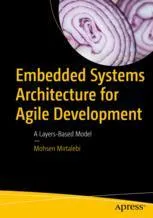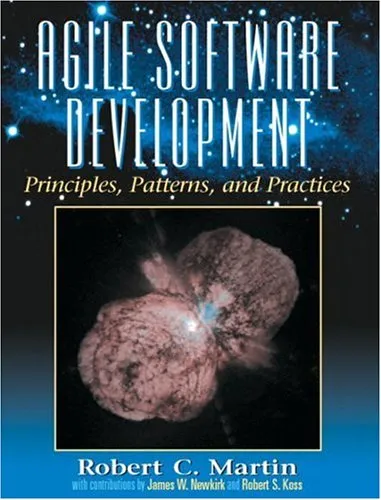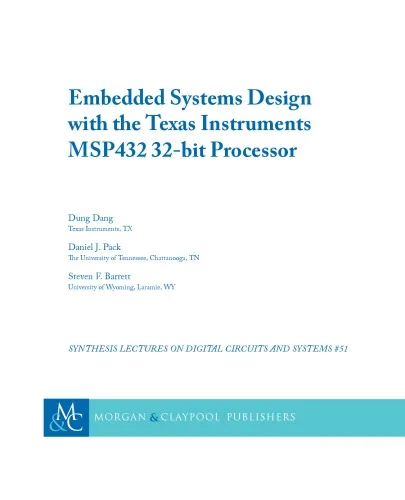Embedded Systems Architecture for Agile Development: A Layers-Based Model
4.0
بر اساس نظر کاربران

شما میتونید سوالاتتون در باره کتاب رو از هوش مصنوعیش بعد از ورود بپرسید
هر دانلود یا پرسش از هوش مصنوعی 2 امتیاز لازم دارد، برای بدست آوردن امتیاز رایگان، به صفحه ی راهنمای امتیازات سر بزنید و یک سری کار ارزشمند انجام بدینکتاب های مرتبط:
معرفی کتاب
در کتاب "معماری سیستمهای نهفته برای توسعه چابک: مدلی مبتنی بر لایه"، با رویکردی نوین به طراحی و توسعه سیستمهای نهفته پرداختهام که هدف آن تسهیل فرایند توسعه این سیستمها با استفاده از متدولوژیهای چابک و مدلسازی مبتنی بر لایه است. این کتاب به مهندسان، توسعهدهندگان و علاقهمندان به حوزه سیستمهای نهفته کمک میکند تا به شیوهای موثرتر و کارآمدتر با چالشهای طراحی و پیادهسازی مواجه شوند.
خلاصه کتاب
این کتاب از یک مدل معماری مبتنی بر لایه استفاده میکند که در آن به وضوح نقش هر لایه و تعاملات بین آنها مشخص شده است. این ساختار به مهندسان این امکان را میدهد که درک بهتری از پیچیدگی سیستمهای نهفته داشته باشند و در عین حال انعطافپذیری در توسعه را افزایش دهند. با استفاده از Agile Development در کنار این مدل معماری، تیمها میتوانند محصولات خود را سریعتر به بازار عرضه کنند و در عین حال کیفیت و پایداری سیستم را حفظ نمایند.
نکات کلیدی
- استفاده از مدل لایهای برای کاهش پیچیدگی سیستمهای نهفته
- به کارگیری اصول Agile برای افزایش سرعت و انعطافپذیری در توسعه
- راهکارهایی برای بهبود کیفیت و اطمینان از عملکرد سیستمها
- مدیریت بهتر منابع سختافزاری و نرمافزاری
نقل قولهای معروف از کتاب
«اپتیمایز کردن معماری سیستمهای نهفته همچون بهینهسازی یک ارکستر پیچیده از اجزای سختافزاری و نرمافزاری است که نیاز به هماهنگی دقیق و کنترل مداوم دارد.»
چرا این کتاب مهم است
این کتاب با ارائه دیدگاههای جدید در زمینه معماری و توسعه سیستمهای نهفته، به صنعتی که به سرعت در حال تغییر است، کمک میکند تا با چالشهای جدید سازگار شود. مدل لایهای پیشنهاد شده در این کتاب نه تنها به کاهش پیچیدگی سیستمها کمک میکند بلکه به توسعهدهندگان اجازه میدهد که بهبودهای متوالی و مکرری را در محصول نهایی خود پیادهسازی کنند، و این امر اهمیت زیادی در بسیاری از صنایع نظیر خودروسازی، تجهیزات پزشکی، و دستگاههای الکترونیکی مصرفی دارد.
Welcome to the comprehensive guide to modern embedded systems architecture designed for Agile development methodologies. This book, "Embedded Systems Architecture for Agile Development: A Layers-Based Model," encapsulates the evolving landscape of embedded systems in tandem with Agile principles, offering a methodical approach for designing, implementing, and maintaining robust systems in an ever-changing technological environment.
Detailed Summary of the Book
The book introduces a novel perspective on embedded systems development by marrying it with Agile practices, which are traditionally associated with software development. It lays out a layers-based model, emphasizing a modular architecture that is resilient to change, scalable with ease, and adaptable under constraints. This approach helps manage complexity in embedded systems design, fostering an environment where iterative progress, proactive quality management, and rapid adaptation are second nature.
Through a series of well-structured chapters, this book delves into the core principles and practicalities of embedded systems design under the Agile paradigm. It covers architectural patterns, modular decomposition, and design strategies, accompanied by real-world examples and case studies. Over the span of several chapters, readers are guided through a journey that starts with the basics of embedded systems and progresses to complex integrations, providing insights into handling dependencies and optimizing for performance and reliability.
Key Takeaways
- Understanding the importance of Agile principles in modern embedded system development.
- How to implement a layers-based architecture to improve system scalability and flexibility.
- Best practices for iterative development, testing, and integration in embedded environments.
- Strategies to manage complexity and reduce risk in embedded system projects.
- Ways to enhance collaboration between multidisciplinary teams engaged in hardware and software aspects of system design.
Famous Quotes from the Book
"In an era where technological demands shift rapidly, the capacity to pivot through iterative, Agile practices in embedded systems is not just advantageous; it is essential."
"Embedded systems architecture is no longer a static construct but a dynamic tapestry woven through layers, each critical to adapting to change with minimal friction."
Why This Book Matters
Incorporating Agile methods into embedded systems architecture is a relatively new frontier, yet it presents substantial opportunities for innovation and efficiency. This book matters because it bridges the gap between two previously disparate fields, offering novel insights and actionable strategies for developers, engineers, project managers, and technologists. In a sector defined by constraints and high-stakes applications, being able to iterate quickly and effectively can set a groundbreaking precedent in how embedded systems are conceived and engineered.
Furthermore, this book contributes significantly to the discourse around multidisciplinary team dynamics, enhancing how teams manage both hardware and software development cycles concurrently. It therefore not only redefines technical strategies but also revitalizes team collaboration models, thereby elevating entire development ecosystems.
Ultimately, the book serves as a critical resource for any organization looking to stay competitive in the fast-paced world of embedded technologies, ensuring their systems can adapt to changes swiftly and remain resilient amidst evolving demands.
دانلود رایگان مستقیم
شما میتونید سوالاتتون در باره کتاب رو از هوش مصنوعیش بعد از ورود بپرسید
دسترسی به کتابها از طریق پلتفرمهای قانونی و کتابخانههای عمومی نه تنها از حقوق نویسندگان و ناشران حمایت میکند، بلکه به پایداری فرهنگ کتابخوانی نیز کمک میرساند. پیش از دانلود، لحظهای به بررسی این گزینهها فکر کنید.
این کتاب رو در پلتفرم های دیگه ببینید
WorldCat به شما کمک میکنه تا کتاب ها رو در کتابخانه های سراسر دنیا پیدا کنید
امتیازها، نظرات تخصصی و صحبت ها درباره کتاب را در Goodreads ببینید
کتابهای کمیاب یا دست دوم را در AbeBooks پیدا کنید و بخرید
1631
بازدید4.0
امتیاز0
نظر98%
رضایتنظرات:
4.0
بر اساس 0 نظر کاربران
Questions & Answers
Ask questions about this book or help others by answering
No questions yet. Be the first to ask!












